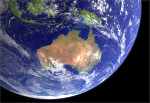There were four drags and passengers were charged sixpence (adults) and threepence (children)
for the ride from the tram terminus.
Once inside, there were camel and pony rides, a monkey circus, birds, kangaroos and emus.
Most of the wildlife was native to Australia and during the 1940s American servicemen were to
make their first acquaintance with kangaroos, koalas, Tasmanian devils, wombats, wedge-tailed eagles and emus in their respective
enclosures.
A reader wiiting to the Herald-Sun paper in 2010 said:
"Peacocks roamed freely and there was much on offer for the children
with free rides on Shetland ponies, donkeys and camels; also a small train which ran on a circular track and a merry-go-round."
The sanctuary closed in 1954 and was sub-divided into 62 blocks - all
the animals were moved to Southport in Queensland for a new sanctuary.
But times past are still immortalised by two local street names -- Wildlife and Maughan Parades.
I recall going to the Park in 1946, in the horse and cart - I remember the huge eagle enclosure, and getting on the donkey for the ride around the circular track. We called that
donkey "Razorback" - the animal was very thin and I am still sore from that ride! (See the picture
below!)
In those days, the area was mainly paddocks and orchards - nowadays it is a residential suburb,
part of Balwyn.
Adjacent to the Sanctuary was a large area of cleared land known as Beckett Park, on a hilltop,which
survives to the present.
The park adjoins Maranoa Gardens at one of the highest points in Melbourne. Formerly known as One Tree Hill, Beckett Park's
stone observation tower still commands views across Melbourne as far as Mt Macedon. And, in the 1940s and 50s Beckett Park
was a traditional site for Empire Day bonfires.
Originally grassy woodland, Beckett Park has been lovingly restored to now be one of our more important revegetation sites
of indigenous species. Visitors can walk through patches of grassy woodlands similar to that which would have been there more
than 100 years ago.
The park is also home to a war memorial, an adventure playground, picnic tables and seating, and public toilets.
Part of the original bushland has been preserved as the Maranoa Gardens, with walking tracks
and pools. On top pf the hill is the Memorial Tower, built in 1919.
From 1906, until 1911, to celebrate Empire Day,
Queen Victoria's Birthday on May 24 each year, there were large torchlight processsions whicgh started at Canterbury
and ended at the the Surrey Gardens in Surrey Hills. These were grand affairs, lasting an hour.
Between 1933 and 1938,
the Empire Day celebrations were revived,climaxing each year with big bonfires at Beckett
Park, until they were abandoned in 1988.
I remember being taken to a bonfire by my father in 1948.

